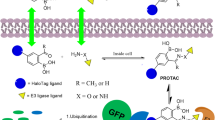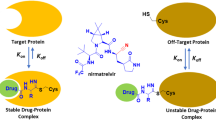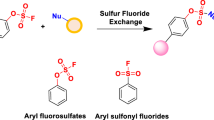Abstract
The reversible covalent attachment of chemical probes to proteins has long been sought as a means to visualize and manipulate proteins. Here we demonstrate the full reversibility of post-translational custom pantetheine modification of Escherichia coli acyl carrier protein for visualization and functional studies. We use this iterative enzymatic methodology in vitro to reversibly label acyl carrier protein variants and apply these tools to NMR structural studies of protein-substrate interactions.



Similar content being viewed by others
References
Luchansky, S.J., Argade, S., Hayes, B.K. & Bertozzi, C.R. Biochemistry 43, 12358–12366 (2004).
Stachler, M.D., Chen, I., Ting, A.Y. & Bartlett, J.S. Mol. Ther. 16, 1467–1473 (2008).
Batra, G. et al. Protein Expr. Purif. 74, 99–105 (2010).
Gauchet, C., Labadie, G.R. & Poulter, C.D. J. Am. Chem. Soc. 128, 9274–9275 (2006).
Hinner, M.J. & Johnsson, K. Curr. Opin. Biotechnol. 21, 766–776 (2010).
Yin, J. et al. Proc. Natl. Acad. Sci. USA 102, 15815–15820 (2005).
Mosiewicz, K.A., Johnsson, K. & Lutolf, M.P. J. Am. Chem. Soc. 132, 5972–5974 (2010).
Wong, L.S., Thirlway, J. & Micklefield, J. J. Am. Chem. Soc. 130, 12456–12464 (2008).
Foley, T.L., Young, B.S. & Burkart, M.D. FEBS J. 276, 7134–7145 (2009).
Meier, J.L. et al. ACS Chem. Biol. 4, 948–957 (2009).
Meier, J.L., Haushalter, R.W. & Burkart, M.D. Bioorg. Med. Chem. Lett. 20, 4936–4939 (2010).
Haushalter, R.W. et al. ACS Chem. Biol. 6, 413–418 (2011).
Murugan, E., Kong, R., Sun, H., Rao, F. & Liang, Z.-X. Protein Expr. Purif. 71, 132–138 (2010).
Quadri, L.E. et al. Biochemistry 37, 1585–1595 (1998).
Chan, D.I. & Vogel, H.J. Biochem. J. 430, 1–19 (2010).
Evans, S.E. et al. J. Mol. Biol. 389, 511–528 (2009).
Płoskoń, E. et al. Chem. Biol. 17, 776–785 (2010).
Roujeinikova, A. et al. J. Mol. Biol. 365, 135–145 (2007).
Roujeinikova, A. et al. Structure 10, 825–835 (2002).
Upadhyay, S.K. et al. J. Biol. Chem. 284, 22390–22400 (2009).
Kitagawa, M. et al. DNA Res. 12, 291–299 (2005).
Lambalot, R.H. & Walsh, C.T. J. Biol. Chem. 270, 24658–24661 (1995).
Foley, T.L. & Burkart, M.D. Anal. Biochem. 394, 39–47 (2009).
Foley, T.L. et al. Org. Biomol. Chem. 8, 4601–4606 (2010).
Worthington, A.S. & Burkart, M.D. Org. Biomol. Chem. 4, 44–46 (2006).
Acknowledgements
We wish to thank (all from UCSD) T.L. Foley for preparing rhodamine-CoA, coumarin-CoA and coumarin-ACP standard; S. Mayfield for providing the luciferase plasmid template; S. Duan for laboratory support; M. Rothmann for assisting with AcpH method development; R. Tsien for use of GFP-related gel-imaging equipment; the UCSD Chemistry & Biochemistry Mass Spectrometry Facility; and J. La Clair for manuscript design input. This research was funded by US National Institutes of Health grants R21AI090213, R01GM094924 and R01GM095970.
Author information
Authors and Affiliations
Contributions
N.M.K. performed all cloning, subcloning, enzymatic reactions, imaging and protein purifications (unless otherwise stated). R.W.H. conducted all protein NMR experiments and provided resulting NMR data. R.W.H. prepared the native Sfp, MBP-CoaA,D,E enzyme stocks used for 'one-pot' chemoenzymatic CoA analog synthesis. A.R.S. synthesized, purified and characterized all oxopantetheine probes in this work. N.M.K., R.W.H., A.R.S. and M.D.B. wrote the manuscript.
Corresponding author
Ethics declarations
Competing interests
The authors declare no competing financial interests.
Supplementary information
Supplementary Text and Figures
Supplementary Figures 1–42, Supplementary Tables 1 and 2, Supplementary Methods and Supplementary Note (PDF 5310 kb)
Rights and permissions
About this article
Cite this article
Kosa, N., Haushalter, R., Smith, A. et al. Reversible labeling of native and fusion-protein motifs. Nat Methods 9, 981–984 (2012). https://doi.org/10.1038/nmeth.2175
Received:
Accepted:
Published:
Issue Date:
DOI: https://doi.org/10.1038/nmeth.2175
- Springer Nature America, Inc.
This article is cited by
-
Gating mechanism of elongating β-ketoacyl-ACP synthases
Nature Communications (2020)
-
Development of an effective protein-labeling system based on smart fluorogenic probes
JBIC Journal of Biological Inorganic Chemistry (2019)
-
In situ regeneration of bioactive coatings enabled by an evolved Staphylococcus aureus sortase A
Nature Communications (2016)
-
Phosphopantetheinylation in the green microalgae Chlamydomonas reinhardtii
Journal of Applied Phycology (2016)
-
Evolution of acyl-ACP thioesterases and β-ketoacyl-ACP synthases revealed by protein–protein interactions
Journal of Applied Phycology (2014)





